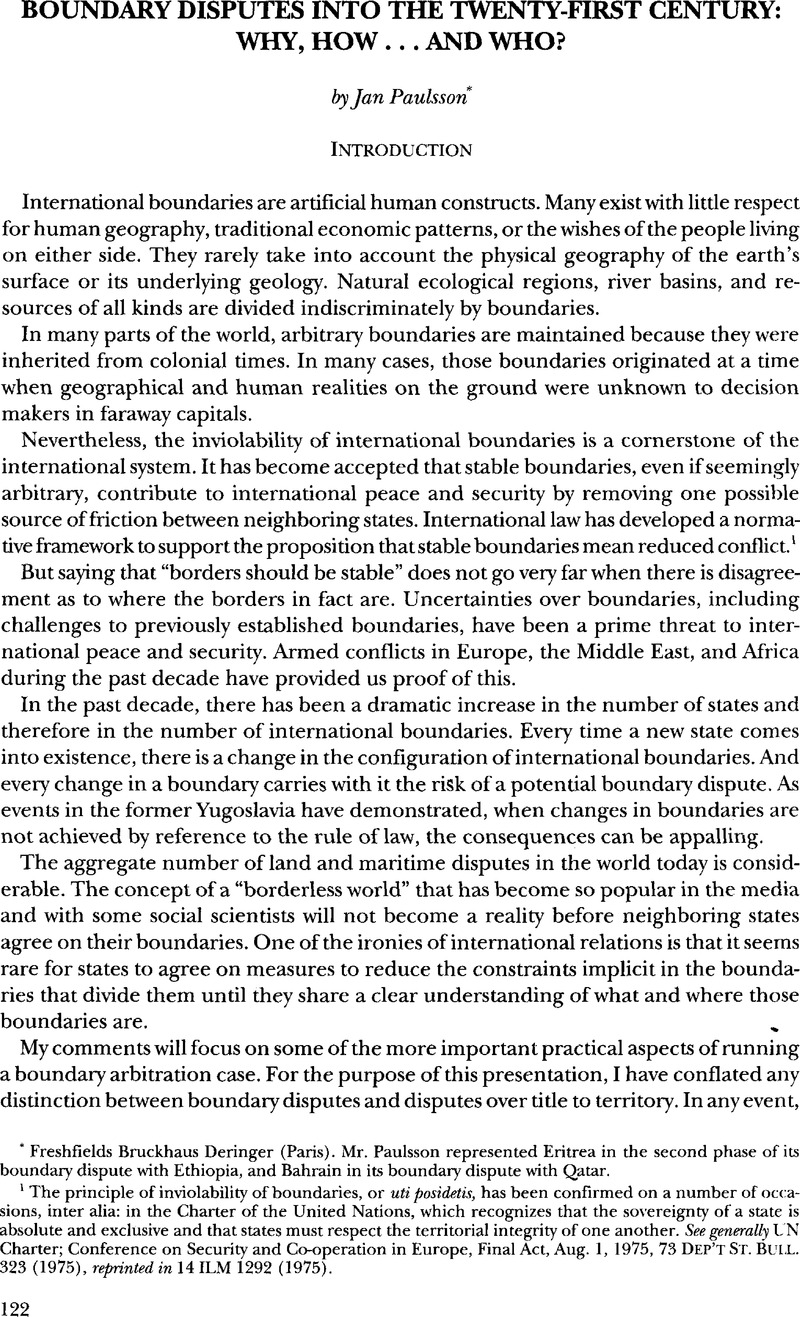Article contents
Boundary Disputes into the Twenty-First Century: Why, How … and Who?
Published online by Cambridge University Press: 28 February 2017
Abstract

- Type
- Meeting Report
- Information
- Copyright
- Copyright © American Society of International Law 2001
References
1 The principle of inviolability of boundaries, or uti posidetis, has been confirmed on a number of occasions, inter alia: in the Charter of the United Nations, which recognizes that the sovereignty of a state is absolute and exclusive and that states must respect the territorial integrity of one another. See generally UN Charter; Conference on Security and Co-operation in Europe, Final Act, Aug. 1, 1975, 73 Dep’t St. Bull. 323 (1975), reprinted in 14 ILM 1292 (1975).
2 Paul K. Huth, Standing Your Ground: Territorial Disputes and International Conflict (1996).
3 Gerald H. Blake, The Resolution of International Boundary Disputes, in Institute of Petroleum, Dispute Resolution in the International Oil and Gas Industries 125,127 (1999).
4 Id. at 128.
5 Id. at 137.
6 Id.
7 Blake, Gerald H. & Swarbrick, Richard E., Hydrocarbons and International Boundaries: A Global Overview, in Boundaries and Energy: Problems and Prospects 6 (Blake, Gerald, Pratt, Martin, Schofield, Clive, & Broum, Janet eds., 1998)Google Scholar [hereinafter Boundaries and Energy] .
8 Gerald H. Blake, Introduction: Energy Flows and International Boundaries, in Boundaries and Energy, supra note 7, at 13, 15.
9 Robson, Charles, Transboundary Petroleum Reservoirs: Legal Issues and Solutions, in The Peaceful Management of Transboundary Resources 3 (Blake, Gerald H., Hildesley, William J., Pratt, Martin A., Ridley, Rebecca J., & Schofield, Clive H. eds., 1995)Google Scholar.
10 GA Res. 3129(1973).
11 Agreement concerning the sovereignty over the islands of Al-’Arabiyah and Farsi and the Delimitation of the Boundary Line Separating the Submarine Areas Between the Kingdom of Saudi Arabia and Iran, Oct, 24, 1968, Saudi Arabia-Iran, 696 UNTS 9976.
12 GA Res. 3281 (1974).
13 Offshore Atlas of World Oil and Gas Theatres (Deverai D. George ed., 1996) ; see also Mark J .Valencia & Jon M. Van Dyke, Comprehensive Solutions to the South China Sea Disputes: Some Options, in Boundaries and Energy, supra note 7, at 122.
14 Seemingly intractable boundary problems involving China and the Koreas are delaying exploration of the South Yellow Sea basin.
15 North Sea Continental Shelf Cases (FRG v. Den.; FRG v. Neth.) ICJREP. 3, 4 (Feb. 20).
16 Id.
17 Carrera, Galo, DELMAR Computer Program Library for the DELimitation of MARitime Boundaries, in Maritime Boundaries 49–58 (Blake, Gerald H. ed., 1994)Google Scholar.
- 3
- Cited by




